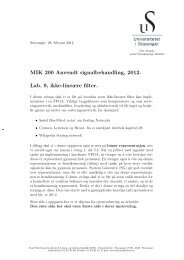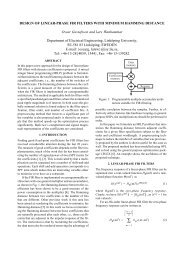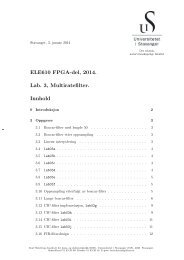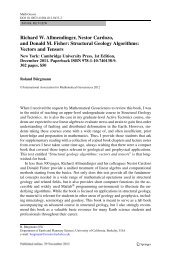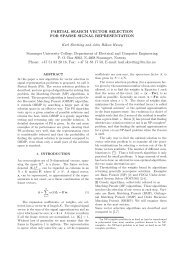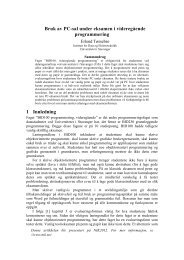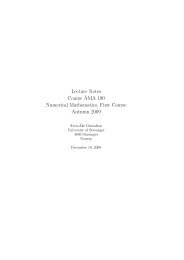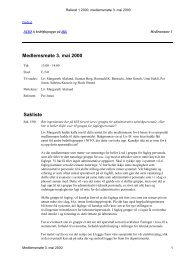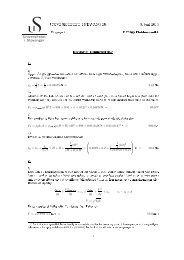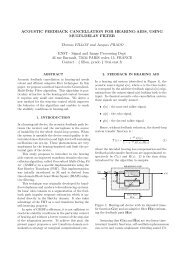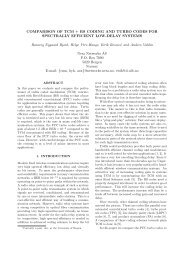MIMO Propagation Channel Models In Underground Environment
MIMO Propagation Channel Models In Underground Environment
MIMO Propagation Channel Models In Underground Environment
You also want an ePaper? Increase the reach of your titles
YUMPU automatically turns print PDFs into web optimized ePapers that Google loves.
where the superscript . H denotes the Hermitian transpose,S and D are respectively Nr Nr and Nt Nt unitarymatrix and V is a Nr Nt diagonal matrix such as (2).V = diag( 1 , 2 , …, N ) (2)with 1 2 … N 0, i being the i-th singular valueof H and N = min(Nr, Nt)The <strong>MIMO</strong> channel capacity is obtained with relation(3).C Nk12. klog 2 (1)Nt(3)with the average signal-to-noise ratio at each receiverbranch.Considering that the square of the singular values arealso the eigen values of H.H H , the <strong>MIMO</strong> channelcapacity can finally be expressed by the equation (4) [1]. C log 2 det(I Nr H . H NtH(4)3. MEASUREMENTS<strong>Channel</strong> matrices H were measured by the TELICELaboratory (France) in a subway tunnel in Paris [3]. Thiswas done in the framework of the ESCORT projectusing a transmission in the GSM-R frequency band. The<strong>MIMO</strong> system is composed of 4 antennas in the train and4 fixed antennas put on a platform. For each position ofthe train, a measurement of the complex impulseresponse between each transmitter and receiver is carriedout. Considering the small delay spread (about 50 ns)obtain in tunnel compared to a typical GSM symbolduration (3.7 s), the impulse responses may be reducedto a complex coefficient. Thus, we obtained for eachposition of the train a 4 4 matrix. The longitudinalattenuation is removed from channel measurements, sothat the matrices H were in accordance with equation (5).E[|h ij | 2 ] = 1 (5)The measured channel matrices allow to compute thecorrelation matrix and the covariance matrix definedbelow.4. <strong>MIMO</strong> CHANNEL MODELS<strong>In</strong> the following we compare three channel models to aRayleigh channel and to measurements results.4.1 Model 1 based on covarianceThis model [4] relies on the computation of thecovariance matrix at the transmitter R TX (Nt Nt) and atthe receiver R RX (Nr Nr).At the transmitter, the covariance coefficient between thei-th and the j-th antenna is expressed in (6) by assumingthat it is independent of the reception antennasNrTX 1ij cov( hki,hkj)Nrk1r (6)At the receiver, the covariance coefficient between the i-th and the j-th antenna is expressed in (7) by assumingthat it is independent of the transmission antennasNtRX 1ij cov( hik,h jk )Ntk 1r (7)We note cov(a, b) the covariance coefficient between aand b such as (8)cov(a, b) = E[a.b * ] – E[a].E[b * ] (8)Then, the channel model matrix is built from (9) asfollowsH model = (R RX ) 1/2 . A.[(R TX ) 1/2 ] T (9)where A is a stochastic Nr Nt matrix with a zero-meancomplex Gaussian distribution with unit variance andmatrix R 1/2 is defined such as R 1/2 .(R 1/2 ) H = R.4.2 Model 2 based on complex correlationAs previously, we define the correlation matrix at thetransmitter TX (Nt Nt) and at the receiver RX(Nr Nr) such as (10) and (11)NrTX 1ij cor( hki,hkj)Nrk1 (10)NtRX 1ij cor( hik,h jk )Ntk 1 (11)We note cor(a, b) the correlation coefficient between aand b defined in (12):cor( a,b )( E[ a2E[ a.b*] E[ a ]] E[ a ].E[ b2).( E[ b2*]] E[ b]2)(12)By assuming that the correlation matrix at the transmitteris independent of the receiver antennas and that thecorrelation matrix at the receiver is independent of thetransmitter antennas [5], the channel correlation matrix (Nt.Nr Nt.Nr) can be expressed as (13)



